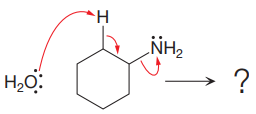
Concept explainers
(a)
Interpretation:
For the given elementary step, it is to be determined whether the reactant or product side is favored.
Concept introduction:
In a bimolecular nucleophilic substitution step (
Answer to Problem 7.37P
For the given elementary step of a

Explanation of Solution
The given elementary step is

The given elementary step is for an

According to the charge stability principle, the negative charge on chlorine is more stable than that on the oxygen atom. Also, the bond energy for the reactant side is higher as compared to the product side. For a reaction or elementary step involving only uncharged species, the side having greater bond energies is favored. Thus, for the above mentioned reaction, the reactant side is favored over the product side.
For a reaction or elementary step involving only uncharged species, the side having greater bond energies is favored.
(b)
Interpretation:
For the given elementary step, it is to be determined whether the reactant or product side is favored.
Concept introduction:
In a bimolecular elimination step (
Answer to Problem 7.37P
For the given elementary step of an

Explanation of Solution
The given elementary step is

The given elementary step is for an
The products for the above reaction, if we assume that the reaction is complete, are as follows:

The product side of the above reaction has two charged species, and a sigma bond is replaced by a pi bond. According to the charge stability principle and total bond energy, the reaction favors the reactant side as the bond energy for the reactant side is more than that of the product.
For a reaction or elementary step involving only uncharged species, the side having greater bond energies and greater charge stability is favored.
(c)
Interpretation:
For the given elementary step, it is to be determined whether the reactant or product side is favored.
Concept introduction:
In a nucleophilic addition step, the nucleophile adds to the polar pi bond. Thus, the nucleophile forms a bond with the less electronegative atom and the pi bond breaks, becoming a lone pair on the more electronegative atom.
A sigma bond between the substrate and the nucleophile forms, whereas the polar pi bond breaks.
Driving force is responsible for an elementary step to go to completion. The driving force for a reaction is the extent to which the reaction favors products over reactants, and that tendency increases with increasing stability of the products relative to the reactants. Charge stability and total bond energy are the two major factors that contribute to a reaction’s driving force. Bond energy refers to the amount of energy needed to break a bond. For a reaction or elementary step involving both ions and uncharged molecules, the side that is favored exhibits greater charge stability. For a reaction or elementary step involving only uncharged species, the side that is favored has greater bond energies.
Answer to Problem 7.37P
For the given elementary step of a nucleophilic addition, the product side is favored over the reactant side.

Explanation of Solution
The given elementary step is

The given elementary step is for a nucleophilic addition.
In the above reaction, the negatively charged carbon serves as a nucleophile and attacks the polar pi bond. The product for the reaction is a charged species with a negative charge on the oxygen atom.
According to the charge stability principle, the negative charge is more stable on the oxygen atom than it is on the carbon atom. So, the reaction is favored in the forward direction. Hence, for the given reaction, the product side is favored over the reactant side.

For a reaction or elementary step involving only uncharged species, the side having greater bond energies and greater charge stability is favored.
(d)
Interpretation:
For the given elementary step, it is to be determined whether the reactant or product side is favored.
Concept introduction:
The electrophilic addition step occurs when a species containing a nonpolar pi bond approaches a strongly electron-deficient species, that is, an electrophile, and a bond is formed between an atom of the pi bond and the electrophile.
Driving force is responsible for an elementary step to go to completion. The driving force for a reaction is the extent to which the reaction favors products over reactants, and that tendency increases with increasing stability of the products relative to the reactants. Charge stability and total bond energy are the two major factors that contribute to a reaction’s driving force. Bond energy refers to the amount of energy needed to break a bond. For a reaction or elementary step involving both ions and uncharged molecules, the side that is favored exhibits greater charge stability. For a reaction or elementary step involving only uncharged species, the side that is favored has greater bond energies.
Answer to Problem 7.37P
For the given elementary step of electrophilic addition, the product side is favored over the reactant side.

Explanation of Solution
The given elementary step is

The given elementary step is for electrophilic addition.
In the above reaction, the nonpolar pi bond attacks the positively charged methyl cation. The product for this reaction is a tertiary carbocation. The methyl carbocation on the reactant side is less stable than the tertiary carbocation on the product side. Therefore, the product side is favored over the reactant side for the above reaction.

For a reaction or elementary step involving only uncharged species, the side having greater bond energies and greater charge stability is favored.
(e)
Interpretation:
For the given elementary step, it is to be determined whether the reactant or product side is favored.
Concept introduction:
The electrophilic elimination step is the reverse of the electrophilic addition step.
In this step, an electrophile is eliminated from the carbocation which generates a stable, uncharged species. A pi bond is formed during the process.
Driving force is responsible for an elementary step to go to completion. The driving force for a reaction is the extent to which the reaction favors products over reactants, and that tendency increases with increasing stability of the products relative to the reactants. Charge stability and total bond energy are the two major factors that contribute to a reaction’s driving force. Bond energy refers to the amount of energy needed to break a bond. For a reaction or elementary step involving both ions and uncharged molecules, the side that is favored exhibits greater charge stability. For a reaction or elementary step involving only uncharged species, the side that is favored has greater bond energies.
Answer to Problem 7.37P
For the given elementary step of an electrophilic elimination reaction, the product side is favored over the reactant side.

Explanation of Solution
The given elementary step is

The given elementary step is for electrophilic elimination.
In the above reaction, the electrophile, that is, the proton is removed or eliminated, and a new pi bond is formed between the two carbon atoms. The product for this step is shown as follows:

The carbocation on the reactant side has an incomplete octet, whereas all atoms in the products have their octets complete. Therefore, the product side is favored over the reactant side.
For a reaction or elementary step involving only uncharged species, the side having greater bond energies and greater charge stability is favored.
(f)
Interpretation:
For the given elementary step, it is to be determined whether the reactant or product side is favored.
Concept introduction:
In the co-ordination step, the electrons from an electron rich site flow to an electron-poor site.
In this step, a new bond known as a co-ordinate bond is formed between the electron-rich and electron-poor atoms.
Driving force is responsible for an elementary step to go to completion. The driving force for a reaction is the extent to which the reaction favors products over reactants, and that tendency increases with increasing stability of the products relative to the reactants. Charge stability and total bond energy are the two major factors that contribute to a reaction’s driving force. Bond energy refers to the amount of energy needed to break a bond. For a reaction or elementary step involving both ions and uncharged molecules, the side that is favored exhibits greater charge stability. For a reaction or elementary step involving only uncharged species, the side that is favored has greater bond energies.
Answer to Problem 7.37P
For the given co-ordination step, the product side is favored over the reactant side.

Explanation of Solution
The given elementary step is

The given elementary step is for the co-ordination reaction.
In the above reaction, the lone pairs of electrons on the nitrogen atom forms a co-ordinate bond with the carbon atom bearing the positive charge. The product for this reaction is shown as below:

The reactant side has a carbocation with an incomplete octet. In the product side, the octets for all the species are complete. Thus, the carbocation on the reactant side is less stable that the positively charged nitrogen atom on the product side. Therefore, the product side is favored over the reactant side.

For a reaction or elementary step involving only uncharged species, the side having greater bond energies and greater charge stability is favored.
Want to see more full solutions like this?
Chapter 7 Solutions
Get Ready for Organic Chemistry
- Nonearrow_forward4. Draw and label all possible isomers for [M(py)3(DMSO)2(CI)] (py = pyridine, DMSO dimethylsulfoxide).arrow_forwardThe emission data in cps displayed in Table 1 is reported to two decimal places by the chemist. However, the instrument output is shown in Table 2. Table 2. Iron emission from ICP-AES Sample Blank Standard Emission, cps 579.503252562 9308340.13122 Unknown Sample 343.232365741 Did the chemist make the correct choice in how they choose to display the data up in Table 1? Choose the best explanation from the choices below. No. Since the instrument calculates 12 digits for all values, they should all be kept and not truncated. Doing so would eliminate significant information. No. Since the instrument calculates 5 decimal places for the standard, all of the values should be limited to the same number. The other decimal places are not significant for the blank and unknown sample. Yes. The way Saman made the standards was limited by the 250-mL volumetric flask. This glassware can report values to 2 decimal places, and this establishes our number of significant figures. Yes. Instrumental data…arrow_forward
- 7. Draw a curved arrow mechanism for the following reaction. HO cat. HCI OH in dioxane with 4A molecular sievesarrow_forwardTry: Convert the given 3D perspective structure to Newman projection about C2 - C3 bond (C2 carbon in the front). Also, show Newman projection of other possible staggered conformers and circle the most stable conformation. Use the template shown. F H3C Br Harrow_forwardNonearrow_forward
 Organic Chemistry: A Guided InquiryChemistryISBN:9780618974122Author:Andrei StraumanisPublisher:Cengage Learning
Organic Chemistry: A Guided InquiryChemistryISBN:9780618974122Author:Andrei StraumanisPublisher:Cengage Learning
